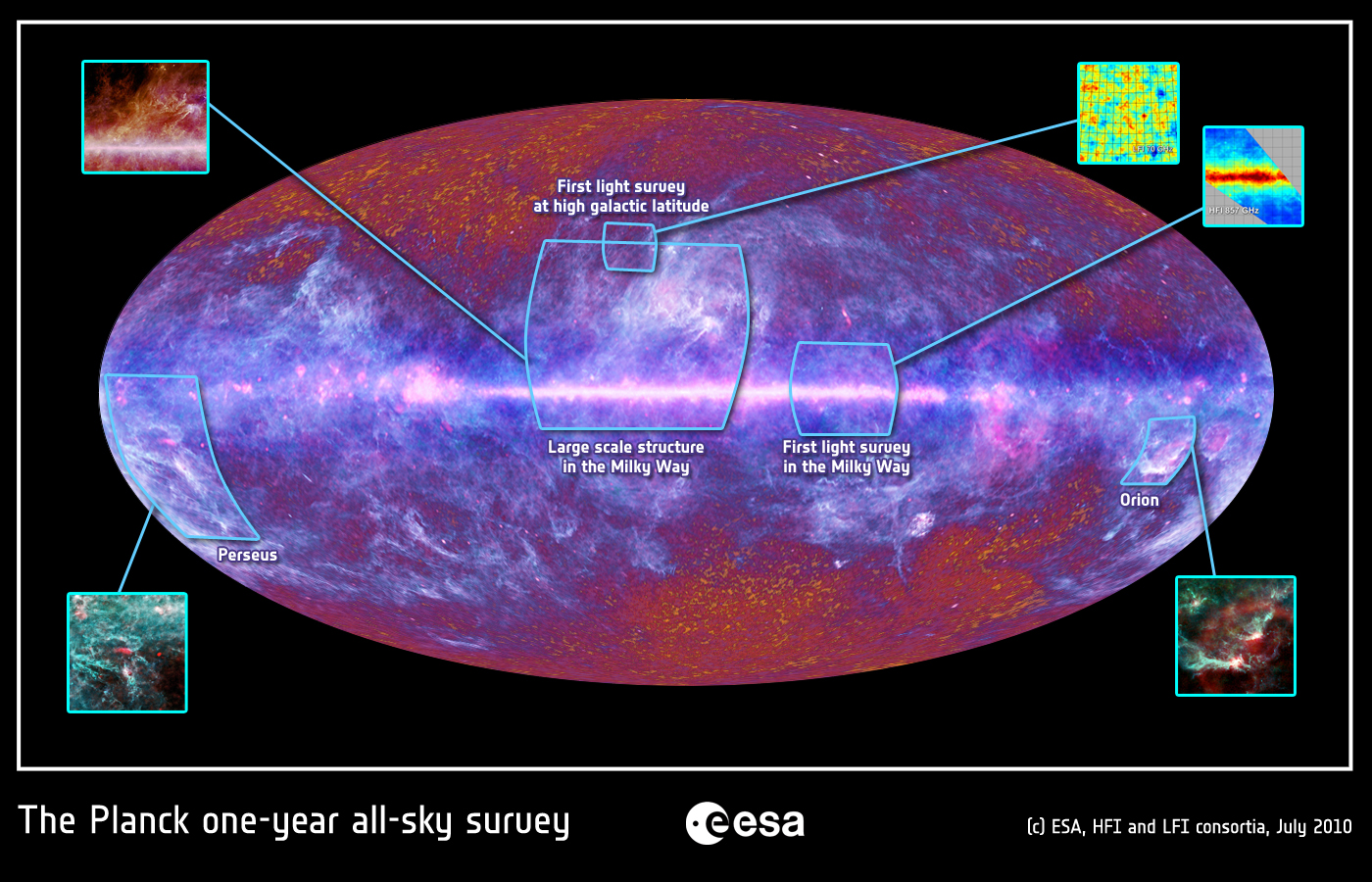Planck is designed to map tiny irregularities in fossil radiation left over from the very first light in the Universe, emitted shortly after the Big Bang, and has enough sensitivity to reach the experimental limits of what can be observed, allowing researchers to peer into the early Universe and study its constituents, perhaps even the hypothetical dark matter and dark energy that continue to be a debate among the science community worldwide.
The main disc of our Galaxy runs across the center of the image. Immediately striking are the streamers of cold dust reaching above and below the Milky Way. This galactic web is where new stars are being formed, and Planck has found many locations where individual stars are edging toward birth or just beginning their cycle of development.

CLICK FOR LARGER SIZE. Multi-frequency all-sky image of the microwave sky has been composed using data from Planck covering the electromagnetic spectrum from 30 GHz to 857 GHz. The mottled structure of the CMBR, with its tiny temperature fluctuations reflecting the primordial density variations from which today’s cosmic structure originated, is clearly visible in the high-latitude regions of the map. The central band is the plane of our Galaxy. A large portion of the image is dominated by the diffuse emission from its gas and dust. The image was derived from data collected by Planck during its first all-sky survey, and comes from about 12 months of observations. To the right of the main image, below the plane of the Galaxy, is a large cloud of gas in our Galaxy. The obvious arc of light surrounding it is Barnard’s Loop – the expanding bubble of an exploded star. Planck has seen whole other galaxies. The great spiral galaxy in Andromeda, 2.2 million light-years from Earth, appears as a sliver of microwave light, released by the coldest dust in its giant body. Other, more distant, galaxies with supermassive black holes appear as single points of microwaves dotting the image. Derived from observations taken between August 2009 and June 2010, this image is a low-resolution version of the full data. Credits: ESA/ LFI&HFI Consortia
Less spectacular but perhaps more intriguing is the mottled backdrop at the top and bottom. This is the ‘cosmic microwave background radiation’ (CMBR). It is the oldest light in the Universe, the remains of the fireball out of which our Universe sprang into existence 13.7 billion years ago.
While the Milky Way shows us what the local Universe looks like now, those microwaves show us what the Universe looked like close to its time of creation, before there were stars or galaxies. Here we come to the heart of Planck’s mission to decode what happened in that primordial Universe from the pattern of the mottled backdrop.
The microwave pattern is the cosmic blueprint from which today’s clusters and superclusters of galaxies were built. The different colours represent minute differences in the temperature and density of matter across the sky. Somehow these small irregularities evolved into denser regions that became the galaxies of today.
The CMBR covers the entire sky but most of it is hidden in this image by the Milky Way’s emission, which must be digitally removed from the final data in order to see the microwave background in its entirety.
Credits: ESA, C. Carreau
When this work is completed, Planck will show us the most precise picture of the microwave background ever obtained. The big question will be whether the data will reveal the cosmic signature of the primordial period called inflation. This era is postulated to have taken place just after the Big Bang and resulted in the Universe expanding enormously in size over an extremely short period.
“This is the moment that Planck was conceived for,” says ESA Director of Science and Robotic Exploration, David Southwood. “We’re not giving the answer. We are opening the door to an Eldorado where scientists can seek the nuggets that will lead to deeper understanding of how our Universe came to be and how it works now. The image itself and its remarkable quality is a tribute to the engineers who built and have operated Planck. Now the scientific harvest must begin."





Comments